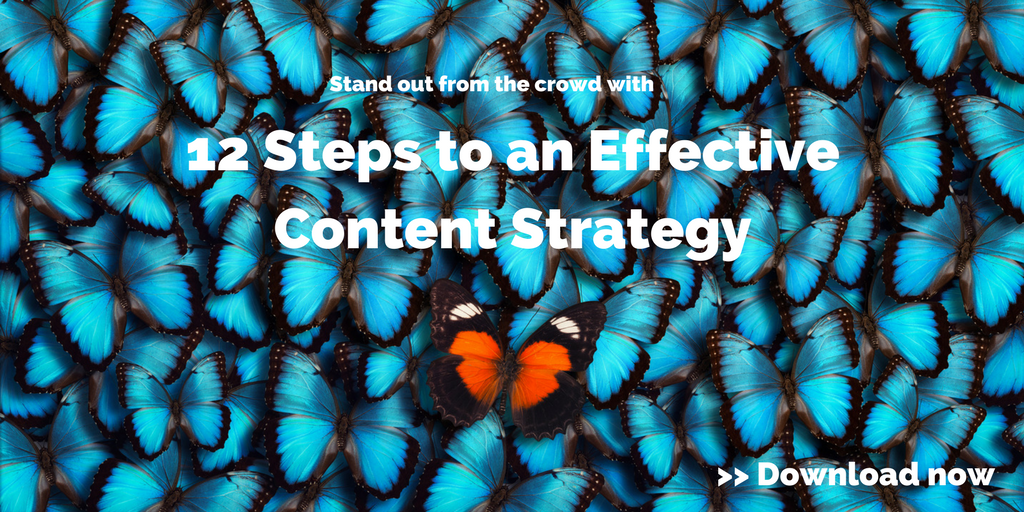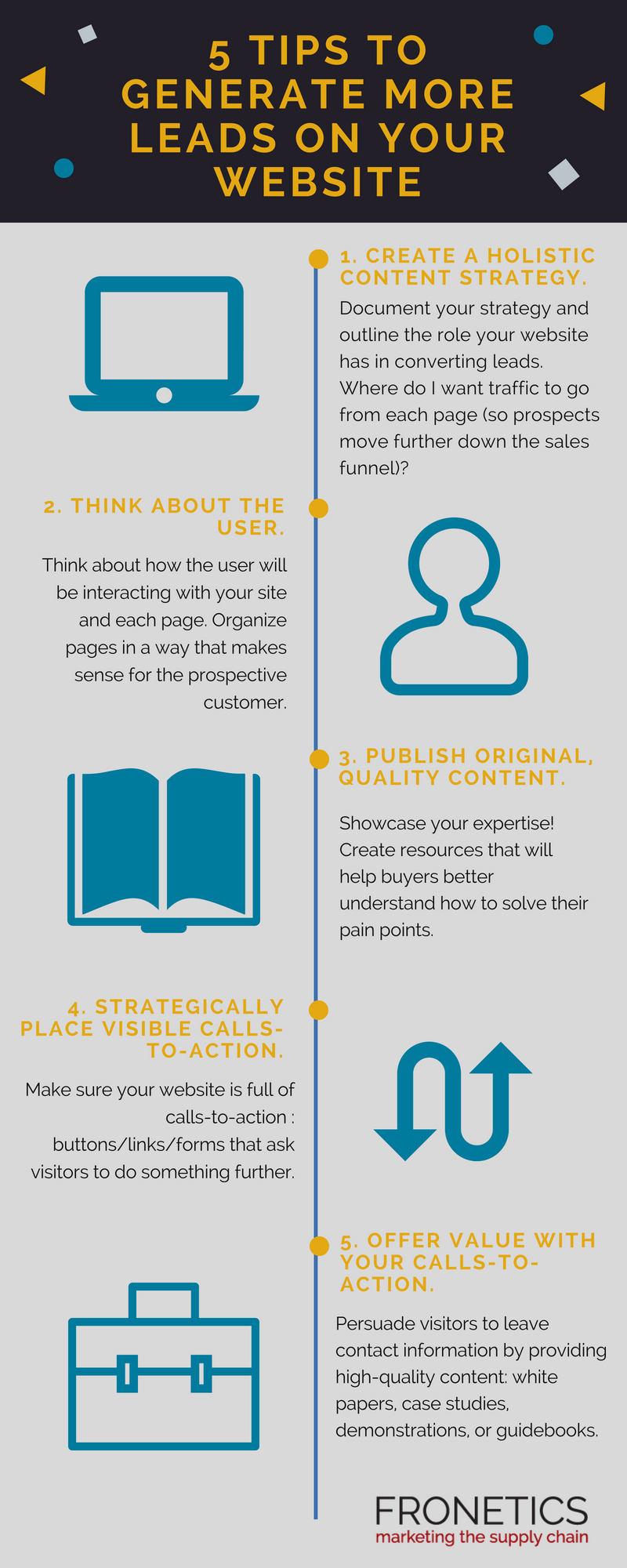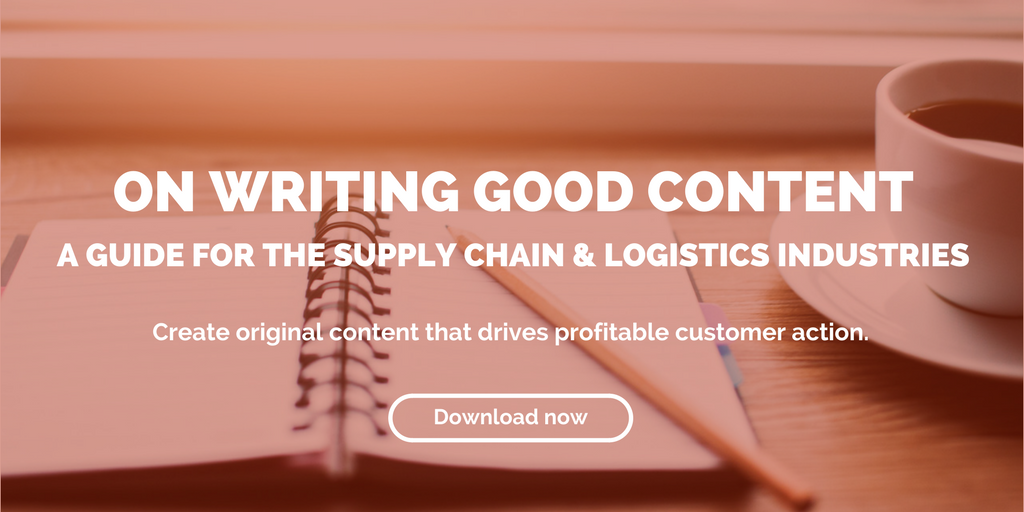
by Fronetics | Jul 18, 2018 | Blog, Content Marketing, Logistics, Marketing, Supply Chain
Once you’ve decided how to create and package a valuable offer, the next step in an effective lead generation is creating calls-to-action that convert leads.
If you read part one of our four-part series on effective lead generation, you’re familiar with the first step in creating a campaign that will generate a high volume of quality leads: creating a valuable offer. So what’s next?
In part two of this series, we’re exploring how to draw visitors from reading content on your website to taking a desired action.
When we talk about this second step, we use the term “call-to-action” (CTA). It refers to the tool that asks the reader of your content to take the next step — rather than just assuming they will do it. A call-to-action can be in-line text with a hyperlink, a button, or an image-based web-banner.
Why do you need a CTA?
CTAs are the vital step where you ask your potential client or buyer to take an action that moves them one stop closer to your objective of connecting them with your company. But plenty of marketers forget this crucial element of an effective campaign.
If you’re offering high-value content (like an ebook, webinar, infographic, or product demonstration), but you aren’t including a specific CTA, you’re not giving your audience direction for obtaining the offer — and you’re probably missing out on plenty of qualified leads.
[bctt tweet=”If your CTAs aren’t effective at capturing the attention of your prospective leads and persuading them to click, then no matter how impressive your offer or how well-written your content, it’s pretty much useless.” username=”Fronetics”]
A CTA is yet another opportunity to optimize your campaign. Remember that you’re competing with every other brand in a fight for the attention of your audience, and you need to make the most of every opportunity to draw them toward your business.
Keep in mind that if your CTAs aren’t effective at capturing the attention of your prospective leads and persuading them to click, then no matter how impressive your offer or how well-written your content, it’s pretty much useless. Your CTA can be used on product pages, in display ads, email, social media, direct mail, or pretty much anywhere you’re marketing your offer.
Elements of calls-to-action that convert leads
Not all CTAs are created equal. As you think about incorporating a call-to-action into your offer, keep in mind these 4 tips for maximizing its productivity:
1. Choose your location wisely.
Back when people read newspapers, editors would place important news “above the fold:” high enough on the page so the reader wouldn’t have to unfold the paper to see it.
A well-placed call-to-action follows the same principle, and should be high enough on the page so your target lead won’t have to scroll down to see it. You should also place a second CTA further down within the offer.
2. Be clear.
You don’t want to leave your reader puzzling about what will happen when he or she follows your CTA. State the offer clearly, and be specific. For instance, rather than “download now,” say “download your free ebook.”
3. Don’t hide your light.
Your call-to-action should stand out on the page. Choose contrasting colors for your CTA, so it draws the eye and doesn’t blend into the rest of your text.
We’ve found, in many cases, our clients have the most success with calls-to-action that are image-based (particularly in emails). A really well-designed, attractive, image-based CTA can effectively draw click-throughs in a way other kinds of calls-to-action can’t. Give it a try!
4. Link to a landing page.
Send potential leads to a targeted landing page that is relevant to what they are looking for. Your CTA should send them to a page that will convert them into a lead.
For more information, check back in with our next post, when we explore how to create a landing page that converts leads.
How do you design calls-to-action that convert leads?
Related posts:


by Fronetics | Jun 21, 2018 | Blog, Content Marketing, Logistics, Marketing, Supply Chain
If you’re looking to generate more leads on your website, you need to create opportunities to capture visitors and implement a strong content strategy to encourage engagement.
Lots of supply chain and logistics companies are catching on to the benefits of content marketing. And of those, many are implementing a content marketing strategy to plan and execute their marketing.
[bctt tweet=”There’s no point in pouring a bunch of time, money, and resources into a robust content marketing program if the website that you’re driving traffic to stinks.” username=”Fronetics”]
But there’s an issue a lot of supply chain and logistics companies are running into: a weak website that doesn’t encourage the generation of leads. Essentially, there’s no point in pouring a bunch of time, money, and resources into a robust content marketing program if the website that you’re driving traffic to stinks.
In a recent post, we talk about what a weak website looks like. If you think you may fall into this category, don’t fret. There is still time to generate more leads on your website.
Consistently producing quality content and making sure you’re utilizing various distribution channels — social media, a blog, etc. — will help draw your target audience to your website. Once they’re on your site, you need to make sure they have a positive user experience. And more importantly, they need ample opportunities to learn more about your products and services.
These opportunities to engage with your content help move users down the sales funnel. You’ll capture leads that have the potential to become sales.
So how do you ensure your website is a lead-generating machine? Here are five tips to generate more leads on your website.
Infographic: 5 tips to generate more leads on your website

(Made with Canva)
Most importantly, remember to be prudent about the role your website plays in the lead-generation process. A strong website with quality content, great visuals, and easily identifiable calls-to-action only works to generate leads and push users down the sales funnel. You’ll still need someone to help close the deal.
Related posts:


by Fronetics | May 23, 2018 | Blog, Content Marketing, Logistics, Marketing, Strategy, Supply Chain
If you’re hoping to generate more leads on your website, you’re going to have to develop a holistic content strategy and create many strong calls-to-action.
You may have read part one of this mini-series about the importance of having a solid website if you’re going to invest in content marketing. Essentially, there’s no point in pouring a bunch of time, money, and resources into a robust content marketing program if the website that you’re driving traffic to stinks.
Be thoughtful about the role your website plays in the lead-generation process. It’s a really important piece of the puzzle that companies often overlook.
Consistently producing quality content and distributing it through various channels, like social media, will help attract your target audience to your website. But unless you provide them with a good user experience while they’re there — and give them plenty of opportunity to opt in to learn more about your business — you’re not going to move them down the sales funnel. And you’re not going to generate more leads on your website.
So how do you ensure your website is a lead-generating machine? Here’s what I know.
5 tips to generate more leads on your website
1) Create a holistic content strategy.
I can’t overstate the importance of creating a content marketing strategy, documenting it, and then designating someone to lead it if you want your content marketing to be successful. As part of that strategy, you should outline the role your website will play in assisting the conversion of leads.
Ask yourself these questions:
- Do different pages of my website suit prospects at different stages of the buyer’s journey?
- Where do I want traffic to go from each page (so prospects move further down the funnel)?
- What calls-to-action can I add to each page to assist them in that move?
- Which pages are ripe for lead conversion, and which are better for providing information?
- If you’re using the topic cluster model (which you should be!), where are my pillar pages and corresponding topic cluster pages?
Also, make sure your messaging is consistent across your website and your regularly published content (like blog posts).
2) Think about the user and how s/he experiences your site.
Hopefully in creating a holistic content strategy that includes your website, you’re thinking primarily about how the user will be interacting with your site and each page. That means organizing pages in a way that makes sense for the prospective customer, rather than internal politics.
That sounds easy, but I have helped many organizations for whom this is incredibly challenging. Often, one department (or person) feels strongly that something very important to them deserves real estate on the homepage or in the main navigation. But, if it’s not something that is meaningful to a prospective customer, you’d best not cave. Doing some usability testing with prospects is a good way to collect data to support your reasoning.
Also to consider: think about the language your buyers are comfortable with, and avoid any overly jargony or technical wording. Make sure to lay things out in a way that is approachable for them. And aim to provide the information they seek, rather than trying to sell them at every step.
3) Publish original, quality content.
Along those same lines, the best way to convince today’s B2B buyer to choose you as a vendor is to win them over with your content. Content marketing is all about positioning yourself as an expert in the industry, after all, the business that knows the most about your product/service.
Instead of promoting your business on every page, use each as an opportunity to showcase your expertise. Create resources that will help buyers better understand how to solve their pain points. And make sure everything you publish is well-written, offers value to prospects, and is completely original. You want people to want to read what you have to say.
Consider incorporating various content formats to cater to different learning preferences:
- In-depth blog posts and articles
- Infographics for visual learners
- Short video tutorials or explainers
- Podcasts for those who prefer audio content
4) Strategically place strong, visible calls-to-action.
I’ve hinted at this one already, but it bears further explanation. Make sure your website is full of calls-to-action, or buttons/links/forms that ask visitors to do something further. After all, how do you expect someone to take an action (like providing their email address) if you don’t ask them to do it?
You can generate more leads on your website by asking visitors to become leads more often.
Make sure these calls-to-action stand out on the page so that visitors’ eyes naturally go there. Be very clear about what you’re asking for and/or what the user will get in return when they complete the action. And, again, be strategic about what you’re asking people to do on which page. You won’t have much luck, for example, asking visitors to call a sales rep on a page that is designed to assist them with initial information-gathering.
Pro tip: Use A/B testing to optimize your CTAs. Try different colors, copy, and placements to see what resonates best with your audience.
5) Offer value with your calls-to-action.
Sometimes it might take a little convincing to get visitors to provide their contact information. The best way to persuade them? Give them something they want in exchange.
We call this high-value content. Examples might include:
- Case studies
- White papers/industry reports
- Webinars
- Tutorials or how-tos
- Demonstrations
- Sneak peaks or previews
- Guides or ebooks
- Podcasts
Ask visitors to download your high-value content by completing a form, which asks for their email address. Set up your marketing automation to email the content to them, then send a series of lead-nurturing emails following up at strategic intervals to keep them moving down the sales funnel.
If you want to generate more leads on your website, follow these five steps. Above all, just be thoughtful about the role your website plays in the lead-generation process. It’s a really important piece of the puzzle that companies often overlook.
Related posts:








